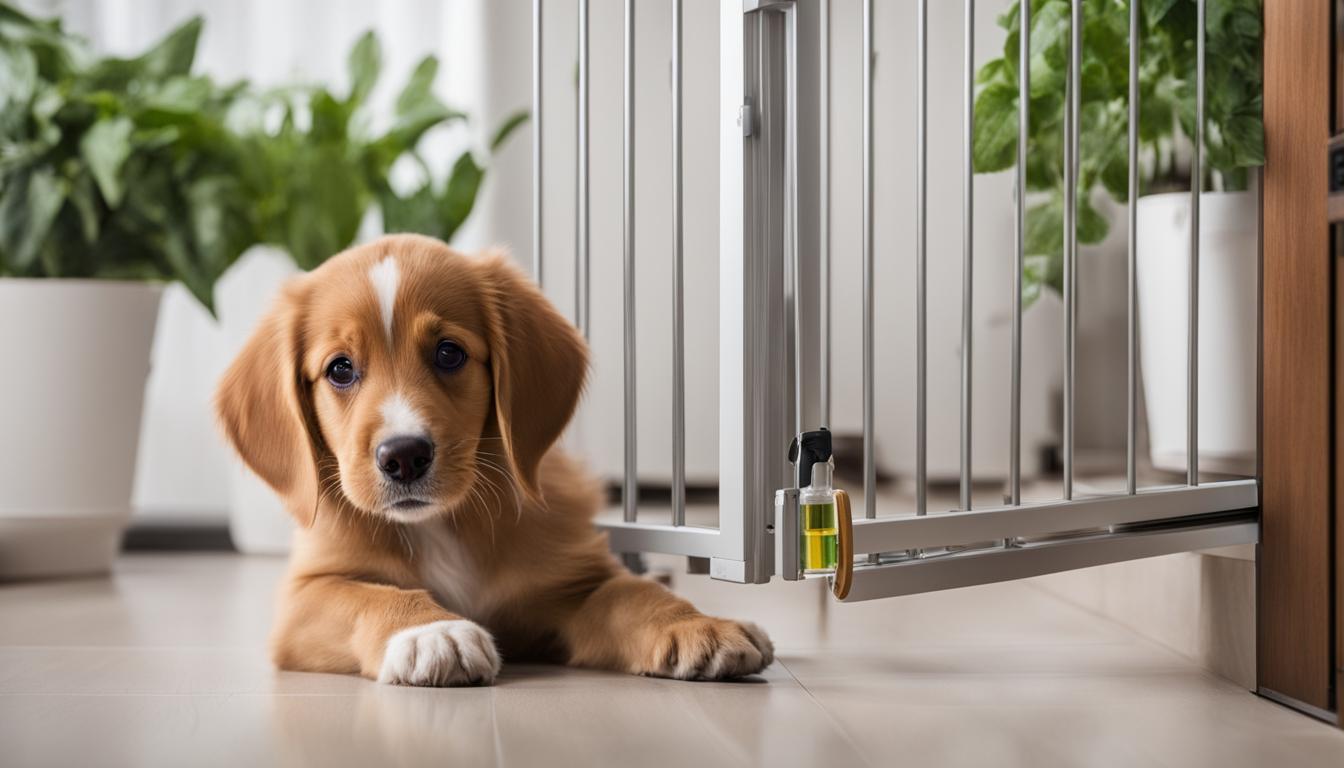Welcome to our comprehensive guide on pet safety! As pet owners, we understand the importance of creating a healthy and secure home environment for our beloved furry friends. From identifying common household hazards to implementing strategies that mitigate risks, we are here to provide you with essential tips that will ensure the well-being of your pets.
Creating a safe space for your pets is not only crucial for their health and happiness but also for your peace of mind. By taking proactive measures to eliminate potential dangers, you can provide a secure haven where your pets can thrive. In this article, we will explore various aspects of pet safety, including household hazards, health and wellness tips, securing your home, yard safety, and more.
Join us as we delve into the essentials of pet safety and learn how to maintain a healthy and secure home environment for our four-legged companions!
Key Takeaways:
- Creating a safe environment is crucial for the well-being of your pets.
- Identify common household hazards and take measures to mitigate risks.
- Promote pet health and wellness through proper nutrition, exercise, and grooming.
- Secure your home against potential threats by using child-safe locks and creating a chewing-proof environment.
- Create a safe outdoor haven in your yard and garden by choosing pet-friendly flora and implementing effective pet containment.
Understanding the Basics of Pet Safety in Your Home
Creating a safe environment for your pets is crucial to their health and well-being. In this section, we will explore the basics of pet safety in your home and provide essential tips for mitigating risks and identifying common household hazards. By implementing these strategies, you can ensure a secure and happy living space for your furry friends.
Identifying Common Household Hazards for Pets
It is important to be aware of the potential hazards that exist within your home to prevent accidents and injuries to your pets. Some common household hazards to watch out for include:
- Toxic substances: Cleaning agents, chemicals, medications, and certain houseplants can be harmful if ingested.
- Electrical cords: Pets may chew on cords, leading to electric shock or injuries.
- Unsecured windows and balconies: These areas can be dangerous for pets, especially if they are not properly secured.
By identifying these hazards, you can take appropriate measures to minimize the risks and create a safer environment for your pets.
Implementing Strategies to Mitigate Risks
Once you have identified the potential hazards in your home, it’s crucial to implement strategies to mitigate these risks. Here are some strategies to consider:
- Store hazardous substances securely: Keep cleaning agents, chemicals, and medications out of your pet’s reach in closed cabinets or high shelves.
- Keep small objects out of reach: Ensure that small objects are stored in containers with secure lids or in areas that are inaccessible to your pets.
- Secure electrical cords: Use cord covers or conceal cords behind furniture to prevent pets from chewing on them.
- Install window screens and balcony barriers: These measures can help prevent accidents and falls.
By implementing these strategies, you can significantly reduce the risks associated with common household hazards and create a safer environment for your pets.
Pet Health and Wellness Tips for a Happy Companion
Ensuring the health and wellness of your pet is crucial for their overall well-being and happiness. Here are some valuable tips to help you take care of your furry friend:
- Nutrition: Provide a balanced and nutritious diet tailored to your pet’s specific needs. Consult with a veterinarian to determine the best food options and feeding schedule for your pet.
- Exercise: Regular exercise is essential for maintaining your pet’s physical and mental health. Engage in activities such as daily walks, play sessions, or interactive toys to keep your pet active and stimulated.
- Grooming: Regular grooming promotes cleanliness and helps prevent common health issues. Brush your pet’s fur to remove tangles and debris, trim their nails to a safe length, and clean their ears and teeth regularly.
- Hydration: Ensure your pet has access to fresh and clean water at all times. Hydration is vital for their overall health and proper bodily functions.
- Regular Check-ups: Schedule regular visits to the veterinarian for routine check-ups and vaccinations. These visits allow for early detection of any potential health concerns and help maintain your pet’s wellness.
- Mental Stimulation: Provide mental stimulation and enrichment activities to prevent boredom and promote mental well-being. Interactive toys, puzzles, and training sessions can help keep your pet mentally stimulated and engaged.
- Parasite Prevention: Protect your pet from parasites such as fleas, ticks, and worms by regularly administering preventive medications as recommended by your veterinarian.
By following these health and wellness tips, you can ensure that your pet remains happy, healthy, and full of vitality!
Securing Your Home Against Potential Pet Threats
In order to ensure the safety of your pets, it is important to take proactive measures to secure your home against potential threats. This includes implementing strategies to protect your pets from toxic substances, keeping edibles out of their reach, and creating a chewing-proof environment.
Using Child-Safe Locks for Toxic Substances
Toxic substances such as cleaning products, pesticides, and certain medications can pose a serious threat to your pets’ health. It is crucial to store these items securely and out of their reach. One effective way to do this is by using child-safe locks on cabinets and drawers where these substances are stored. These locks are designed to prevent easy access and can help ensure that your pets are not exposed to harmful chemicals.
Ensuring Edibles Are Out of Paws’ Reach
Many human foods can be dangerous and even toxic to pets. It is important to keep edibles, such as chocolate, grapes, onions, and certain types of nuts, securely stored where your pets cannot reach them. This includes ensuring that countertops, tables, and other surfaces where food is prepared or served are free from any potential hazards. By keeping edibles out of their reach, you can prevent accidental ingestion and potential health issues.
Creating a Chewing-Proof Environment
Pets, especially puppies and kittens, have a natural instinct to chew on things. This can lead to accidents and injuries if they chew on objects that are hazardous or pose a choking risk. To create a chewing-proof environment, it is important to keep electrical cords, small objects, and other potential hazards out of your pets’ reach. Use cord covers or hide them behind furniture to prevent pets from chewing on them. Additionally, provide plenty of safe and appropriate chew toys to redirect their chewing behavior.
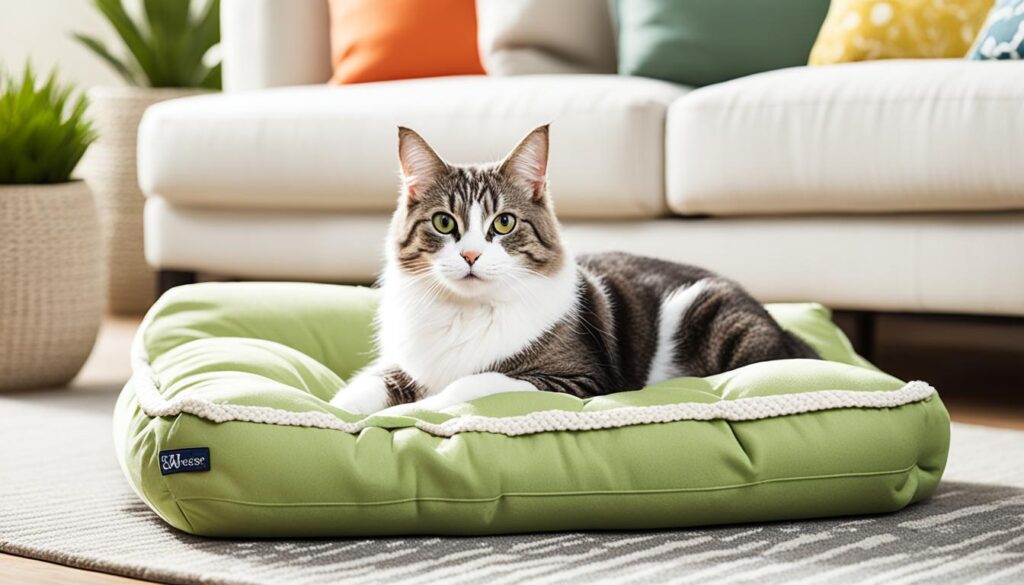
By implementing these strategies, you can significantly reduce the risks and potential threats to your pets within your home. Remember, ensuring a secure and safe environment is essential for the well-being of your furry friends.
Yard and Garden: Creating a Safe Outdoor Haven
Creating a safe outdoor space for your pets is essential to ensure their well-being and happiness. Your yard and garden can be transformed into an outdoor haven where your furry friends can explore, play, and relax. In this section, we will provide valuable tips on yard safety, choosing pet-friendly flora, and fence considerations for effective pet containment.
Choosing Pet-Friendly Flora
When selecting plants for your yard and garden, it’s important to choose pet-friendly flora that is safe for your pets to interact with. Some plants can be toxic to animals if ingested. To create a pet-friendly environment, consider the following:
- Research pet-safe plants: Prioritize plants that are non-toxic to pets, such as marigolds, zinnias, and sunflowers. Avoid plants like lilies, daffodils, and azaleas, which can be harmful to cats and dogs.
- Keep harmful plants out of reach: If you have plants that are toxic to pets, ensure they are placed in areas that are inaccessible to your furry friends, such as elevated planters or hanging baskets.
- Create barriers if necessary: If certain plants need extra protection, consider using barriers like garden fences or plant enclosures to keep your pets away from them.
Fence Considerations for Pet Containment
Fencing plays a crucial role in keeping your pets safe and contained within your yard. Here are some important fence considerations to ensure the safety of your pets:
- Height: The height of the fence should be sufficient to prevent your pets from jumping or climbing over it. A fence with a minimum height of 4 to 6 feet is generally recommended.
- Materials: Choose durable and pet-friendly materials for your fence, such as vinyl, wood, or metal. Avoid chain-link fences with large gaps, as small pets may be able to squeeze through them.
- Secure gates: Ensure that all gates are securely latched to prevent your pets from accidentally escaping.
- Check for gaps and holes: Regularly inspect the fence for any gaps or holes that your pets could squeeze through or use as an escape route. Repair any damages promptly.
By implementing these fence considerations, you can create a secure outdoor space where your pets can enjoy the fresh air while remaining safely contained within your yard.
| Yard Safety Tips | Pet-Friendly Flora | Fence Considerations |
|---|---|---|
| Regularly inspect your yard for potential hazards and remove them. | Choose pet-safe plants and keep toxic plants out of reach. | Install a fence with an appropriate height and secure gates. |
| Ensure that any chemicals or pesticides used in your yard are pet-safe. | Create barriers around plants that are particularly tempting to your pets. | Regularly check for gaps and holes in the fence and repair them promptly. |
| Provide shaded areas and fresh water for your pets in the yard. | Consider using elevated planters or hanging baskets for toxic plants. |
Pet-Proofing Strategies for Every Room
In order to ensure the safety of your pets in every room of your house, it is important to implement effective pet-proofing strategies. By identifying and addressing potential hazards, you can create a secure environment for your furry friends. Here are some practical tips:
- Secure wires and cords: Pets can be curious and may chew on electrical cords, which can lead to electric shock or other injuries. Keep wires and cords out of your pet’s reach or use cord organizers to conceal them.
- Remove toxic plants: Certain plants can be toxic to pets if ingested. Research pet-friendly plants and remove any toxic ones from your home.
- Store cleaning products: Keep cleaning products, including detergents and chemicals, in cabinets or areas that are inaccessible to pets. This will prevent accidental ingestion and potential harm.
- Secure cabinets and drawers: Use childproof locks or latches to secure cabinets and drawers that contain items hazardous to pets, such as medications or sharp objects.
- Keep small objects out of reach: Small objects like buttons, coins, or batteries can pose choking hazards to pets. Ensure that these items are stored safely and are not accessible to your furry friends.
By implementing these pet-proofing strategies, you can create a safe and secure environment for your pets in every room of your house.
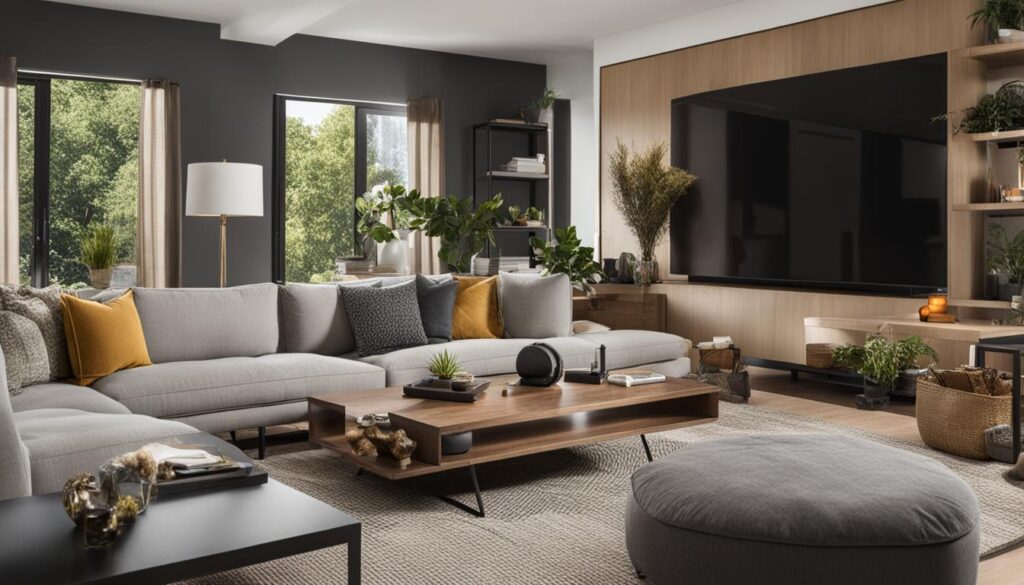
Keeping Your Pets Safe in the Kitchen and Living Areas
This section focuses on keeping your pets safe in the kitchen and living areas of your home. These areas often contain potential hazards that can pose risks to your furry friends. By addressing these hazards and implementing preventive measures, you can create a secure environment for your pets.
Addressing Hazards in High-Risk Areas
In the kitchen and living areas, it’s crucial to be aware of and address the potential hazards that could endanger your pets. Some common high-risk areas include:
- Countertops and tables: Pets may be tempted to jump up onto these surfaces, where they can potentially access harmful substances or objects.
- Electrical cords: Pets may chew on electrical cords, which can lead to electrocution or other injuries.
- Unstable furniture: Pets may climb or jump onto unstable furniture, which can result in falls or accidents.
- Open windows: Pets may accidentally fall out of open windows, especially if there are no protective measures in place.
By identifying these hazards and taking appropriate action, such as using cord protectors, securing furniture, and installing window screens, you can minimize the risks to your pets in these areas.
Storing Food and Trash Securely to Avoid Temptation
Properly storing food and trash is essential for pet safety. Here are some tips to avoid temptation and potential risks:
- Food storage: Store all food items in pet-proof containers or cabinets to prevent your pets from accessing them. This is particularly important for foods that are toxic to pets, such as chocolate, grapes, and onions.
- Trash management: Use trash cans with secure lids and keep them in areas that are inaccessible to your pets. Dispose of potentially harmful items, such as bones or sharp objects, in a secure manner to prevent accidental ingestion or injuries.
By taking these precautions, you can significantly reduce the chances of your pets being exposed to harmful substances or ingesting items that could cause health issues.
By addressing hazards in high-risk areas and storing food and trash securely, you can create a safer environment for your pets in the kitchen and living areas of your home.
Laundry and Bath Safety: Preventive Measures
In this section, we will discuss important preventive measures to ensure the safety of your pets in the laundry and bath areas. By taking these precautions, you can minimize potential hazards and create a secure environment for your furry companions.
Proper Storage of Cleaning Agents and Detergents
One of the key aspects of laundry safety is properly storing cleaning agents and detergents. These household products can be toxic to pets if ingested, leading to serious health issues. To prevent accidental ingestion, follow these preventive measures:
- Store cleaning agents and detergents in cabinets or high shelves out of reach of pets. Ensure that the storage area is secure and cannot be easily accessed by curious animals.
- Use child-proof locks or latches to secure cabinets containing laundry and cleaning products. These safety measures can help prevent pets from opening cabinet doors and accessing potentially harmful substances.
- Keep cleaning agents in their original containers with proper labels. This ensures that you can easily identify the contents and follow usage instructions without confusion.
- Dispose of empty containers properly by rinsing them thoroughly and tightly sealing them before placing them in a designated trash bin. Do not leave empty containers lying around where pets can access and potentially chew on them.
Securing Appliances to Eliminate Curiosity Dangers
Appliances in the laundry and bath areas can pose curiosity dangers to pets. To prevent accidents and injuries, consider the following preventive measures:
- Secure washing machines and dryers to prevent pets from climbing inside. Ensure that these appliances are stable and cannot tip over easily. Use safety straps or brackets to secure them to nearby walls or cabinets.
- Keep appliance doors closed or locked when not in use. This prevents pets from accessing potentially dangerous areas where they may get stuck or injured.
- Unplug appliances such as hair dryers, electric razors, and curling irons after use. Store them safely out of reach to avoid burns or electrocution hazards.
By implementing these preventive measures, you can create a safer environment for your pets in the laundry and bath areas. Remember to always supervise your pets and provide them with a secure space where they can thrive and stay out of harm’s way.
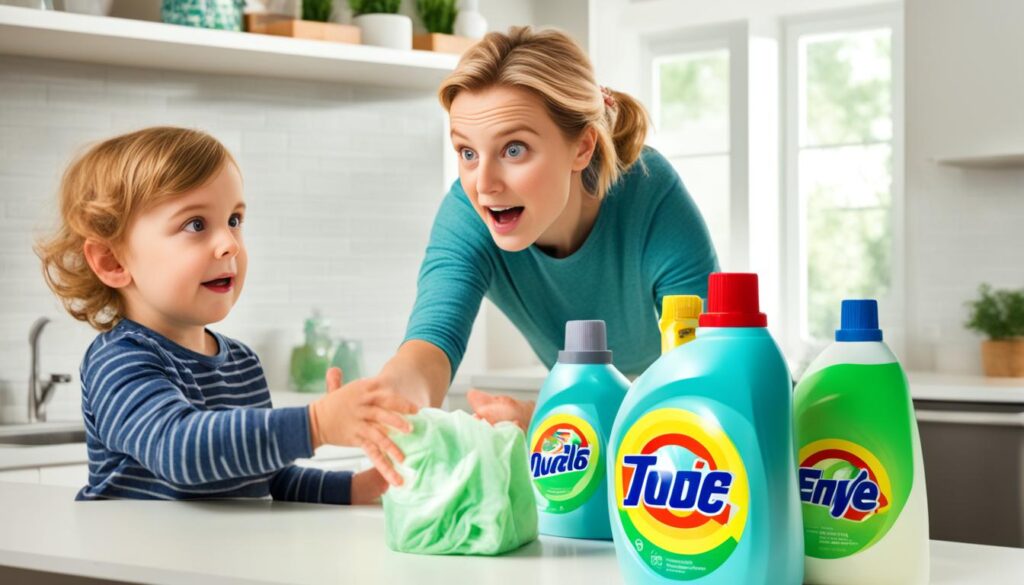
Travel and Transportation: Ensuring Pet Safety On-the-Go
When it comes to traveling with your pets, their safety should always be a top priority. Whether you’re going on a short road trip or a long journey, taking the necessary precautions can make a significant difference in keeping your furry friends secure and comfortable. In this section, we will provide you with valuable tips on how to ensure pet safety during travel and transportation.
Choosing the Right Restraints and Barriers for Vehicles
One of the essential aspects of pet travel safety is properly restraining your pets inside vehicles. Just like humans, pets should be secured to prevent any potential accidents or injuries. There are several options available for pet restraints, including harnesses, seat belts, and crates. The key is to choose the restraint that is suitable for your pet’s size, comfort, and behavior.
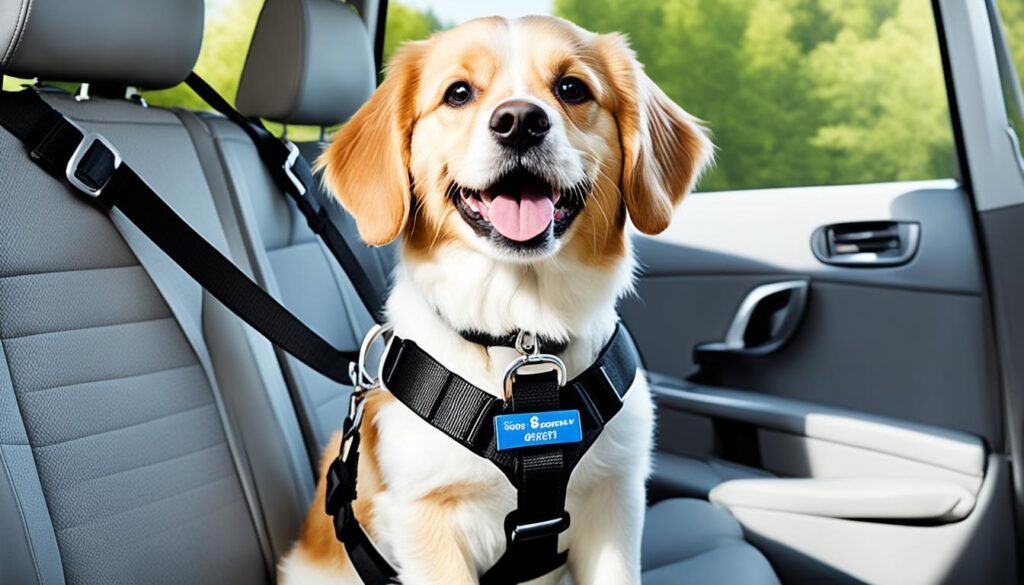
Harnesses and seat belts are ideal for medium to large-sized dogs and can be attached to existing seat belts in the car. However, for smaller dogs or cats, a pet carrier or crate might be a safer option. Make sure the carrier is well-ventilated and secure within the vehicle to prevent it from sliding or tipping during sudden stops or turns.
If you choose to use a crate, ensure it is properly sized and has comfortable bedding. It’s important not to restrict your pet’s movement completely; they should be able to stand, turn around, and lie down comfortably.
Preparing for Pet-Friendly Stops During Long Trips
During long trips, it’s crucial to plan for pet-friendly stops to provide your pets with necessary breaks, exercise, and bathroom breaks. Research and locate pet-friendly rest areas, parks, or walking trails along your route beforehand. These stops will give your pets a chance to stretch their legs, relieve themselves, and burn off some energy.
Remember to keep your pets on leashes or in a secured area during these stops to ensure their safety and prevent them from running off. Additionally, always carry waste bags to clean up after your pets and be respectful of the surroundings so that other pet owners can also enjoy these pet-friendly spaces.
By choosing the right restraints and barriers for your pets in vehicles and preparing for pet-friendly stops during long trips, you can ensure their safety and make the travel experience enjoyable for everyone involved. With these precautions in place, you can embark on your journey with peace of mind, knowing that your pets are well-protected and comfortable.
Emergency Preparedness: First Aid and Crisis Management
In this section, we will cover emergency preparedness for pets, including first aid and crisis management. It’s essential to be prepared for any unforeseen emergencies that may arise, ensuring that you can provide immediate care and support to your furry friends in times of need.
Assembling a Pet First Aid Kit
To effectively handle pet emergencies, it’s crucial to have a well-stocked pet first aid kit on hand. The kit should include essential items that can help address injuries, provide temporary relief, and stabilize your pet until you can seek professional veterinary assistance. Some key items to include in your pet first aid kit are:
- Gauze pads and bandages for wound care
- Antiseptic cleanser for disinfection
- Tweezers for removing splinters or ticks
- Scissors to cut tape or bandages
- Hydrogen peroxide for inducing vomiting (only under veterinary guidance)
- Disposable gloves for personal protection
- Emergency contact numbers for your veterinarian, local animal hospitals, and poison control
- Any specific medications or supplies recommended by your veterinarian for your pet’s unique needs
By assembling a comprehensive pet first aid kit and keeping it easily accessible, you can quickly respond to emergencies and provide necessary care until professional help is available.
Learning Basic Pet CPR and Emergency Procedures
In addition to having a pet first aid kit, it’s crucial to familiarize yourself with basic pet CPR and emergency procedures. By learning these life-saving techniques, you can provide immediate assistance to your pet and potentially save their life in critical situations.
Important Note: It’s essential to consult with a veterinarian or professional instructor to receive proper training in pet CPR and emergency procedures. This will ensure that you have accurate information and guidance tailored to your pet’s specific needs.
Learning pet CPR is a valuable skill that can help you revive a pet that has stopped breathing. The technique involves chest compressions and mouth-to-snout resuscitation. Familiarize yourself with the proper steps and practice on a mannequin or with guidance from a professional.
In addition to CPR, you should also learn other emergency procedures such as how to address choking, manage bleeding, and identify signs of distress in your pet. Being prepared and knowledgeable in these areas can make a significant difference during critical situations.
Remember, quick and effective action during emergencies can help minimize further harm and increase the chances of a positive outcome for your beloved pet.
Advancing Pet Wellness Through Technology and Surveillance
Technology and surveillance play a significant role in pet wellness, allowing pet owners to monitor and ensure the safety and well-being of their furry companions. With the rapid advancements in technology, pet owners now have access to a wide range of innovative products and surveillance systems that can enhance the overall quality of life for their pets.
One such technological advancement is the advent of wearable pet devices. These devices, such as GPS trackers and activity monitors, provide real-time information about a pet’s location, activity levels, and overall health. With the help of these devices, pet owners can keep track of their pet’s daily exercise routines, set goals, and even monitor their sleeping patterns. This valuable data allows pet owners to make informed decisions regarding their pet’s wellness and detect any potential issues at an early stage.
Another significant advancement in pet wellness technology is the integration of smart home devices. Smart cameras and sensors can be strategically placed around the house to monitor the activities of pets, even when the owners are away. These surveillance systems provide real-time video feeds, allowing pet owners to remotely check on their pets, ensure they are safe, and identify any potential hazards or unusual behavior.
Additionally, technology has revolutionized the way pet owners communicate with their pets. Interactive toys equipped with cameras and audio capabilities enable pet owners to interact with their pets remotely, providing mental stimulation and combating loneliness, which is especially beneficial for pets that spend long periods alone at home.
Incorporating technology and surveillance systems into our daily lives can greatly contribute to the well-being and safety of our beloved pets.
In conclusion, technology and surveillance systems offer numerous benefits for pet wellness. From wearable devices that track health and location to smart home integration and interactive toys, pet owners now have unprecedented access to tools that enhance the quality of their pet’s lives. By embracing these advancements, we can ensure that our pets are safe, healthy, and happy companions.
Conclusion
Throughout this article, we have provided essential tips for ensuring pet safety in a healthy and secure home. By implementing these strategies, you can create an environment that promotes the well-being and happiness of your furry companions.
Identifying common household hazards is the first step in safeguarding your pets. By recognizing potential dangers such as toxic substances, edibles, and chewing hazards, you can mitigate risks and prevent accidents or injuries.
In addition to securing your home, it’s crucial to prioritize your pet’s health and wellness. Proper nutrition, regular exercise, and grooming are key factors in maintaining their overall well-being and preventing health issues.
Creating a safe outdoor haven in your yard and garden is equally important. By choosing pet-friendly flora and ensuring proper containment with appropriate fences or barriers, you can allow your pets to enjoy the outdoors safely.
Remember, emergency preparedness is vital. Assembling a pet first aid kit, learning pet CPR, and understanding basic emergency procedures can make all the difference in critical situations.
In conclusion, by prioritizing pet safety and implementing the tips shared in this article, you can provide a secure and loving home for your beloved pets. Stay vigilant, and remember that their well-being is in your hands.
FAQ
What are some common household hazards for pets?
Some common household hazards for pets include toxic substances, electrical cords, small objects that can be swallowed, open windows or balconies, and hot surfaces.
How can I mitigate the risks of household hazards for my pets?
To mitigate the risks of household hazards for your pets, you can use child-safe locks for toxic substances, secure electrical cords out of reach, keep small objects stored safely, use window screens or safety barriers, and create pet-friendly spaces away from hot surfaces.
What are some pet health and wellness tips?
Some pet health and wellness tips include providing a balanced diet and fresh water, regular exercise, grooming and dental care, vaccinations and preventive medications, and regular veterinary check-ups.
How can I secure my home against potential threats to my pets?
You can secure your home against potential threats to your pets by using child-safe locks for toxic substances, ensuring that edibles are out of their reach, creating a chewing-proof environment by removing hazards, and installing secure fences or barriers.
What are some tips for creating a safe outdoor haven for pets in my yard and garden?
Some tips for creating a safe outdoor haven for pets in your yard and garden include selecting pet-friendly flora that is non-toxic, avoiding plants that can be harmful if ingested, and ensuring effective pet containment with secure fences or enclosures.
How can I pet-proof every room in my home?
To pet-proof every room in your home, you can secure wires and cords out of reach, remove toxic plants and chemicals, store medications in closed cabinets, and remove small objects or potential hazards that could be ingested or cause harm.
How can I keep my pets safe in the kitchen and living areas?
You can keep your pets safe in the kitchen and living areas by addressing hazards such as hot stoves and open flames, securely storing food and trash to avoid temptation, and avoiding the use of toxic cleaning products in their presence.
What preventive measures should I take in the laundry and bath areas to keep my pets safe?
To keep your pets safe in the laundry and bath areas, you should store cleaning agents and detergents in closed cabinets, avoid leaving washing machines or dryers accessible, and secure appliances to eliminate the risk of curiosity dangers.
How can I ensure my pets’ safety when traveling and during transportation?
You can ensure your pets’ safety when traveling and during transportation by choosing the right restraints or carriers for vehicles, providing comfortable and secure travel arrangements, and planning for pet-friendly stops during long trips.
What should I do in case of an emergency involving my pets?
In case of an emergency involving your pets, it is important to assemble a pet first aid kit, learn basic pet CPR and emergency procedures, and have contact information for emergency veterinary care readily available.
How can technology and surveillance contribute to advancing pet wellness?
Technology and surveillance systems can contribute to advancing pet wellness by providing monitoring capabilities, such as pet activity trackers, pet cameras, and smart home devices that can help ensure the safety and well-being of your pets.
Source Links
- https://www.statefarm.com/simple-insights/family/pet-safety-tips
- https://www.security.org/resources/keeping-pets-safe/
- https://www.cnet.com/home/kitchen-and-household/the-ultimate-pet-safety-guide-securely-leave-your-dogs-and-cats-home-alone/

